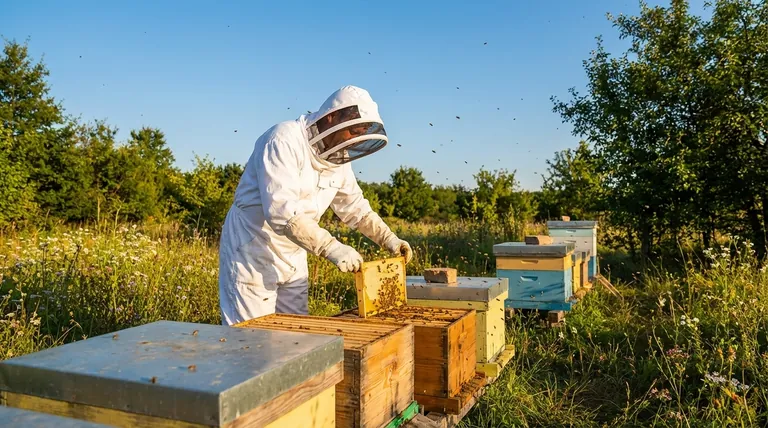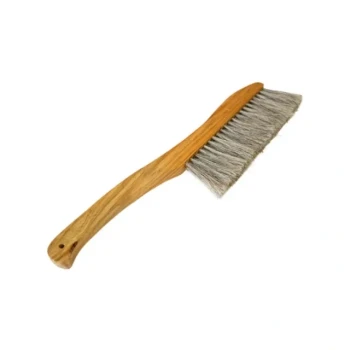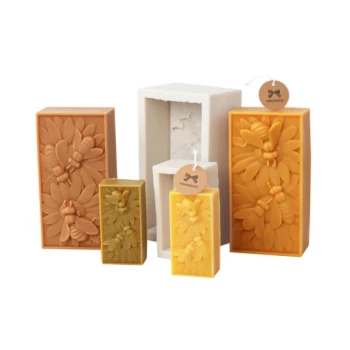For new beekeepers, the most significant initial decision regarding protective clothing is choosing between a full bee suit and a bee jacket. This choice is not merely about comfort; it fundamentally shapes your early experiences, directly impacting your sense of safety and your ability to learn with confidence.
The decision between a suit and a jacket is a choice between managing risk and managing comfort. For a beginner, minimizing risk by choosing maximum protection is the superior strategy, as it removes the fear of stings and allows you to focus entirely on learning the language of the bees.

The Two Primary Options: Suit vs. Jacket
Your protective gear is the barrier between you and the bees' primary defense mechanism. Understanding the fundamental difference between the two main options is the first step.
The Full Bee Suit: Maximum Protection
A full bee suit is a single garment that provides head-to-toe coverage, integrating a veil, torso and arm protection, and full-length leg coverings. It is sealed with zippers and elastic at the wrists and ankles.
The primary advantage is its impenetrable security. There are no gaps at the waist for a curious bee to crawl into, offering unparalleled peace of mind.
The Bee Jacket: A Balance of Convenience
A bee jacket combines the essential veil and torso protection into a single upper-body garment. It is designed to be worn with your own durable pants, such as thick jeans or work trousers.
Jackets are often quicker to put on and take off for brief hive inspections. However, their crucial weakness is the gap at the waist, which creates a potential entry point for bees.
Why Your Initial Choice Is Critical for Learning
The gear you choose for your first season does more than just prevent stings; it sets the psychological stage for your entire beekeeping journey.
Building Confidence, Not Fear
As a beginner, your main goal is to learn to read the hive and handle the bees calmly. A full suit removes the distraction and anxiety of potential stings.
This allows you to move slowly and deliberately, which in turn keeps the bees calmer. A sting-free experience allows you to focus on the bees' behavior, not on your own fear.
Understanding Your Personal Tolerance
Most new beekeepers do not know how their body will react to bee venom. A single sting can be painful, but multiple stings can be dangerous for those with a sensitivity.
Starting with maximum protection is the most responsible way to operate until you have a clear understanding of your personal tolerance.
Understanding the Trade-offs
Every equipment choice in beekeeping involves balancing competing factors. Being aware of these trade-offs allows you to make an informed decision rather than a reactive one.
Protection vs. Comfort
A full bee suit, while secure, is inevitably hotter and can feel more cumbersome than a jacket. This is a significant consideration in warm climates.
A jacket provides better ventilation but sacrifices the complete security of a one-piece suit. This trade-off is often not worth the risk for a beginner.
The Risk of an Incomplete Barrier
The single greatest drawback of a jacket is the waist gap. Even with your shirt tucked in, a determined bee can find its way inside.
A single bee crawling on your skin is far more unnerving than dozens flying around your veil. This experience can quickly end an inspection and erode your confidence.
Gloves: Dexterity vs. Security
This same principle applies to gloves. Thick leather gloves offer maximum sting protection but limit your dexterity.
Thinner nitrile gloves provide a much better feel for manipulating frames but offer minimal protection from a direct sting. Many experienced beekeepers transition to nitrile, but beginners benefit from the security of leather.
Making the Right Choice for Your First Season
Your goal is to create the best possible learning environment for yourself. The gear you select is a critical tool for achieving that.
- If your primary focus is maximizing safety and building confidence: Choose a full, light-colored bee suit. This is the recommended path for nearly all new beekeepers as it eliminates the physical and mental barrier of potential stings.
- If your primary focus is hand protection: Start with ventilated leather beekeeping gloves for maximum security, and consider trying double-layered nitrile gloves later as your confidence and skills grow.
- If you absolutely cannot use a full suit due to extreme heat: A high-quality jacket can work, but you must be diligent about wearing thick pants and ensuring the jacket and pants have a significant, secure overlap. You are consciously accepting a higher risk.
Your protective gear is the tool that empowers you to become a calm, confident, and effective beekeeper.
Summary Table:
| Option | Protection Level | Best For | Key Consideration |
|---|---|---|---|
| Full Bee Suit | Maximum (Head-to-Toe) | New Beekeepers, High-Risk Scenarios | Eliminates waist gap; hotter but offers complete peace of mind. |
| Bee Jacket | Moderate (Upper Body) | Quick Inspections, Experienced Beekeepers | Faster on/off; risk of bees entering via waist gap. |
| Gloves (Leather) | Maximum Sting Protection | Beginners | Sacrifices dexterity for security. |
| Gloves (Nitrile) | Minimal Protection | Confident Beekeepers | Better feel for frames; less sting protection. |
Start Your Beekeeping Journey with Confidence.
Equip yourself with the right protective gear from HONESTBEE. We supply durable, high-quality bee suits, jackets, and gloves designed for commercial apiaries and distributors. Our wholesale-focused operations ensure you get the reliable equipment you need to build a safe and successful beekeeping practice.
Contact HONESTBEE today for wholesale inquiries and let us help you protect your passion.
Visual Guide

Related Products
- Cotton Beekeeping Suit and Round Hat with Veil Bee Keeper Protective Gear
- White Beekeeping Protective Suit and Hat with Fencing Veil for Beekeepers
- Professional Beekeeping Suit for Kids and Girls Childrens Bee Keeper Suit
- Heavy Duty Cowboy Beekeeper Hat with Visibility Veil Outdoor Professional Beekeeping Protective Gear
- Friendly Bee Mascot Costume Vibrant Engaging Promotional Asset
People Also Ask
- What should be considered regarding the color of beekeeping clothing? Ensure Your Safety and Keep Bees Calm
- What factors should be considered when choosing a beekeeping suit? Balance Safety, Comfort & Performance
- Why is a jacket with a hat veil recommended for beekeepers? Essential Protection for Your Face and Neck
- Do beekeeping suits completely prevent stings? Maximize Your Apiary Safety with the Right Gear
- How should a bee suit be cleaned? Protect Your Investment and Ensure Apiary Safety



















